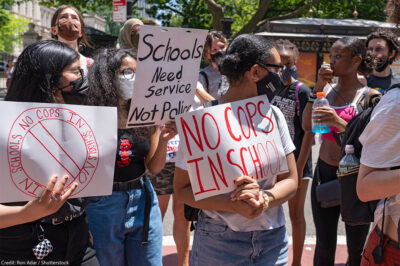
Last week during his historic trip as the first sitting U.S. president to visit a federal prison, President Barack Obama was struck by how youthful mistakes, not unlike his own, could feed the mass incarceration pipeline and land young people in jail —potentially for life.
“[H]ow do we make sure that those same kind of institutional supports are there for kids and teenagers before they get into the criminal justice system, and are there ways for us to divert young people who make mistakes early on in life so that they don’t get into the system in the first place.”
(Here are the stories that President Obama would have heard if he had visited incarcerated youth.)
Fortunately for President Obama, a bill that directly addresses his question not only already exists but has begun the process of moving toward his desk. While much of the country’s focus is on reforming the U.S. adult criminal justice system, a strong bipartisan group of senators are working to ensure that these protections extend to our nation’s youth. Today the Senate Judiciary Committee will markup the Juvenile Justice Delinquency Act of 2015, introduced by Chairman Chuck Grassley. It is compassionate legislation designed to divert at risk youth from a life of institutionalization and protect kids who are incarcerated.
Even though much of the focus is on reforming the adult justice system, research clearly shows that we cannot reduce mass incarceration without juvenile justice reform. An Arkansas Division of Youth Services study found that incarceration is the single most significant factor in predicting whether a youth will offend again, more so even than poor family relationships or gang affiliation. Another study of Chicago youth processed by the Juvenile Court of Cook County found that “incarceration as a juvenile increases the probability of recidivism as an adult by 22‐26 percentage points.”
For girls, sexual abuse is among the primary predictors of girls’ involvement with juvenile justice systems, yet systems are often ill-equipped to identify or treat the problem. Former Kentucky Department of Justice Commissioner Hasan Davis describes how children enter the system as victims of abuse and neglect, only to later be locked up for running away from abusive homes as teenagers.
One of those teenagers was Sarah.
Over a 3-year period, she spent 40 days locked up for missing school and running away without ever having committed a crime. When Commissioner Hasan last saw Sarah, she was being detained on criminal charges. Resources used to detain Sarah could have been more humanely and cost effectively used to prevent her earlier victimization.
A few days prior to his visit of El Reno Federal Correctional Institution, President Obama commuted the sentences of 46 individuals — 14 of whom had been serving life sentences — who were in prison for nonviolent drug offenses. While reducing mandatory minimum sentencing rules for nonviolent drug offenders is a crucial component of criminal justice reform, President Obama must also take concrete steps to counteract our society’s zeal for incarcerating kids.
If we truly care about stopping mass incarceration, we must end it for the weakest and most vulnerable members of society — our kids. The most effective sentencing reform is keeping the next generation out of prison in the first place. The JJDPA will help at-risk children receive the interventions that they need to ensure that they are able to spend their childhood in the classroom instead of the courtroom.




